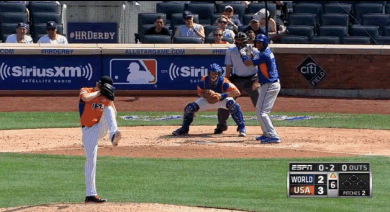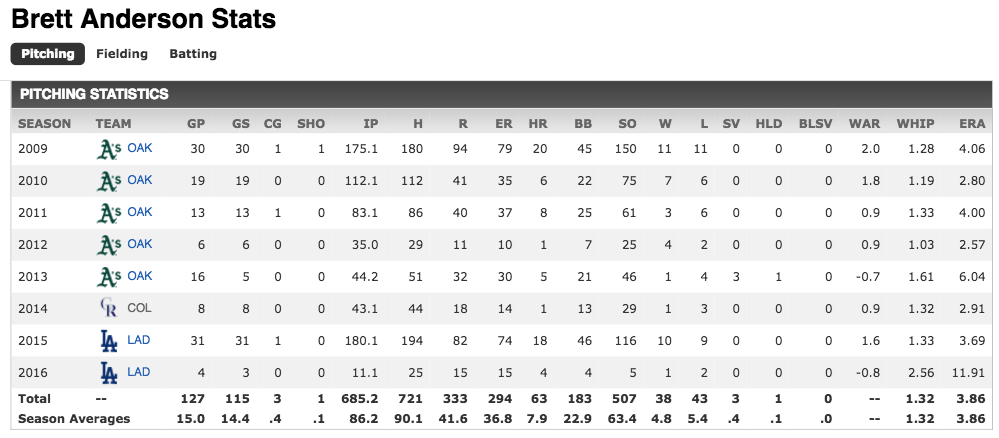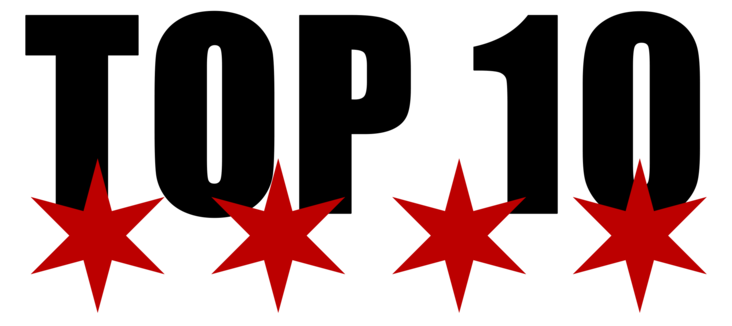Follow our new Twitter account for real-time updates and in-depth analysis of all things Chicago Cubs.
The 2017 season is going to answer a lot more questions about the Chicago Cubs than you automatically think of before the 162-game journey begins. Can the Cubs repeat as World Series champions? No team has done it since the New York Yankees won three in a row from 1998-2000. But that’s not why you clicked.
The Cubs are once again projected to have another monster season and by every metric, ranking and predictions are expected to make it to the postseason for the third consecutive year. For the past two years manager Joe Maddon has had the luxury of having one of the healthiest and most consistent starting rotations in MLB. In 2016, the Cubs had five pitchers who made at least 29 starts, fueling a 2.96 ERA that led the Majors for team starting pitchers.
This year, it won’t be much of an issue. Of course, that’s taking health for granted, but Jon Lester, Jake Arrieta, Kyle Hendricks and John Lackey are all back to fill out the rotation. Lefties Mike Montgomery and Brett Anderson, are the two favorites to win the fifth spot in the rotation and how they perform in 2017 might give fans an indication as to what direction the Cubs go in 2018 and beyond.
See, the big problem that the Cubs could be facing after the 2017 season is replacing two and maybe even three pitchers in the starting rotation.
Follow our new Twitter account for real-time updates and in-depth analysis of all things Chicago Cubs.
Lester and Hendricks are guaranteed to be back, but Lackey and Arrieta will be free agents after the 2017 season and right now both are good bets not to return to the Cubs. Lackey will be turning 39-years-old in October, so don’t expect the front office to give him any more money after his $32 million, two-year deal expires. Meanwhile, Arrieta will be 32-years-old for the 2018 season and if he remains adamant about getting a $200 million deal, there’s no way the Cubs re-sign him, especially after not getting far in contract extension talks during the previous two winters.
That being said, Arrieta has expressed interest in wanting to return to the Cubs after 2017.
Jake Arrieta doesn't want to see his time end with the #Cubs, leaves door open to contract extension. He's a free agent after 2017 season. pic.twitter.com/d9sPFrbRdm
— Aldo Soto (@AldoSoto21) February 15, 2017
Regardless, I just can’t see him backing down from his demands, nor the Cubs giving in to those contract demands. And yes, he’s going to get a huge deal as a free agent.
Bam! Losing at least 40 percent of your starting rotation isn’t exactly what any team is looking forward to and that’s exactly why the Cubs are scooping up low-risk, high-reward pitchers. So, that’s why 2017 will be much more important for the future than you think.
Who are the options to come into the rotation in 2018? You might think the Cubs will just open up their pockets and look at free agency, but the starting pitching class is weak heading into the offseason. The next big option is via a trade, but we’ll get into that later on.
Right now, here are the guys the Cubs have who will have a shot to perform in 2017 and make a case to join the starting five in 2018.
Most Likely
- Mike Montgomery
Hell, he might even be in the rotation this season, but some really bad things have to happen for Montgomery not to be in the starting rotation in 2018. The absolute worst-case scenario is Montgomery gets plenty of starts this year and he pitches poorly, so the Cubs figure that he’d be more valuable in the bullpen, where he’s been primarily used from since he was acquired from the Seattle Mariners. Otherwise, Montgomery is a lock to be in the rotation and did well the few times he did start for the Cubs last year.
Montgomery, 27, will be a free agent after the 2021 season.
Maybe…?
- Eddie Butler
- Alec Mills
- Brett Anderson
Eddie Butler and Alec Mills are two starting pitchers the Cubs traded for with the Colorado Rockies and Kansas City Royals, respectively. These two right-handed pitchers are the classic reclamation projects. Butler is a former first-round pick, who was painfully underwhelming with the Rockies, while Mills was let go after the Royals signed Jason Hammel despite a nice season in the Minor Leagues in 2016.
The numbers for Butler aren’t pretty. He made 28 starts with the Rockies, making 36 total appearances over three seasons and ended up with a 6.50 ERA in 159.1 innings. That includes a 1.77 WHIP. Bad. So, what’s the hope for Butler?

 Check out this FanGraphs article by Eno Sarris, who breaks down an incredible changeup that Butler once had, but lost and needs to get back to become effective. The positive? Butler appears to have developed a good slider and still throws 93 mph, but the game-changer for Butler remains getting back his changeup.
Check out this FanGraphs article by Eno Sarris, who breaks down an incredible changeup that Butler once had, but lost and needs to get back to become effective. The positive? Butler appears to have developed a good slider and still throws 93 mph, but the game-changer for Butler remains getting back his changeup.
That’s a good pitch. He’s still throwing 93. The sinker has decent outcomes (55% grounders, 5% whiffs, both above average). He’s found a slider. That’s the now for Eddie Butler, and it’s more exciting than his results were last year.
The future? If it works out for him, and for the Cubs, who could use starting-pitching depth behind the six they’ll have in the majors, it’ll have more to do with his past than his present. He’ll find that changeup again, and he’ll find that promise that once made him a first-round pick and a Futures Game GIF monster.
(Eno Sarris)
There’s some guy on the Cubs who I’ve heard has a pretty good changeup.


Maybe he can help out Butler.
For Mills, there are some positives. He had Tommy John Surgery in 2013, but came back and pitched extremely well in 2015, which was his first full professional season. Mills made 21 starts in 2015, posting a 3.02 ERA in 113.1 innings. Then, he made the jump to Double-A last year and was more impressive, lowering his ERA to 2.39 over 67.2 innings. Overall in 2016, Mills recorded a 3.22 ERA and 1.19 WHIP in 125.2 innings.
Mills is 25-years-old, while Butler turns 26 in March. They’ll both see some action with the Cubs this year, as the club continues to emphasize not over-working their starting pitchers and eventually using a six-man rotation later in the year.
Brett Anderson is going to be an intriguing option for the Cubs after this year. The lefty signed a one-year deal, with a bunch of incentives. The key for Anderson is obviously staying healthy because the rundown on his injury history is ridiculous. Bleacher Nation’s Michael Cerami wrote about Anderson and went through all of the pitcher’s stints on the disabled list.
- April 27, 2010: 15-day DL with left elbow inflammation and forearm strain
- June 4, 2010: 15-day DL
- June 7, 2011: 15-day DL with left elbow soreness
- July 31, 2011: Transferred to 60-day DL
- March 13, 2013: 60-day DL
- May 1, 2013: 15-day DL with sprained right ankle
- June 14th, 2013: Transferred to 60-day DL
- April 13, 2014: 15-day DL with fractured left index finger
- April 25, 2014: Transferred to 60-day DL
- August 6, 2014: 15-day DL with lower back strain
- August 16, 2014: Transferred to 60-day DL
- April 3, 2016: 60-day DL after back surgery
- August 23, 2016: 15-day DL with left index finger blister
Anderson is 29-years-old and since making his MLB debut in 2009, he’s made 115 starts, including some great stretches with the Oakland A’s and the Colorado Rockies. However, those great performances by Anderson were in 2010, 2011 and most recently in 2014. He did have a solid 2015 season with the Los Angeles Dodgers, making 31 starts, with a 3.69 ERA and 1.33 WHIP in 180.1 innings.

 So yes, Anderson has shown more than just a few flashes of being a good arm for a starting rotation, but if he can’t show the Cubs that he can stay healthy, he only made three starts with the Dodgers in 2016, then they’ll most likely move on from him. Yet, if he does get through a full season with no hiccups and pitches well, then he immediately becomes a priority for the Cubs. Again, the free agent market for pitchers after 2017 isn’t filled with many great options, so Anderson might get overpaid. Overpaying happens in free agency no matter what, so that wouldn’t be anything new. Just look at Rich Hill, who came out of nowhere during the previous year and a half and earned himself a three-year, $48 million deal this past offseason.
So yes, Anderson has shown more than just a few flashes of being a good arm for a starting rotation, but if he can’t show the Cubs that he can stay healthy, he only made three starts with the Dodgers in 2016, then they’ll most likely move on from him. Yet, if he does get through a full season with no hiccups and pitches well, then he immediately becomes a priority for the Cubs. Again, the free agent market for pitchers after 2017 isn’t filled with many great options, so Anderson might get overpaid. Overpaying happens in free agency no matter what, so that wouldn’t be anything new. Just look at Rich Hill, who came out of nowhere during the previous year and a half and earned himself a three-year, $48 million deal this past offseason.
As a Cubs fan, you want them to re-sign Anderson because that means he was pretty damn good in 2017.
The Young Arms
- Rob Zastryzny
- Duane Underwood Jr.
- Dylan Cease
- Trevor Clifton
What have the Cubs done better than any other team in MLB during the past five years? Draft, trade for and develop star position players. What’s been lacking? Not much young star power in terms of pitching in the farm system. They’ve tried, drafting 107 pitchers since Theo Epstein took over, but as CSN Chicago’s Patrick Mooney pointed out last week, only Zastryzny has reached the MLB level out of the 107.
Zastryzny is the most feasible from this group to make the rotation in 2018. The 24-year-old made his MLB debut in August of 2016, and was fantastic out of the bullpen. He pitched 16 innings, posted a 1.13 ERA, 1.06 WHIP, surrendering only a .207 batting average and .497 OPS to hitters. That came after making 68 starts in the Minors from 2013-16.
Cool, but what would be even better is if one of the other three pitchers has an incredible breakout 2017 and somehow gets into the conversation of making the rotation in 2018. Yet, that chance is slim.
Will Underwood finally live up to his potential and stay healthy? Time will tell for the 22-year-old, who is on the 40-man roster and will pitch for the Cubs down in Arizona this spring training. In 2016, Underwood struggled at Double-A Tennessee, going 0-5, with a 4.91 ERA in 13 starts.
Meanwhile, Clifton and Cease haven’t even pitched above the A-ball level. Clifton was the minor league pitcher of the year for the Cubs in 2016, leading the Carolina League with a 2.88 ERA, 1.16 WHIP and .225 appoints batting average.
Cease, 21, has only pitched 68.2 innings in the minors. Again, these guys are long, long, very long shots to even enter the discussion of the starting rotation.
The rotation can be a problem in 2018, but it’s not all doom and gloom for Epstein and the rest of the front office. They’ll continue to draft pitchers, and at this point pitching coach Chris Bosio has proven to turn around careers of underachieving pitchers.
In Theo we trust, right?
Yep. But it is something to keep your eye on and see who the Cubs look for to be in the starting rotation in 2018 and beyond.












